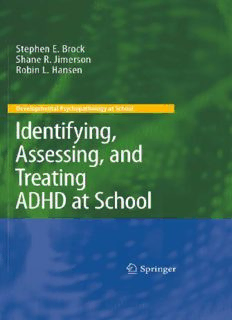
Identifying, Assessing, and Treating ADHD at School PDF
Preview Identifying, Assessing, and Treating ADHD at School
DevelopmentalPsychopathologyatSchool SeriesEditors: StephenE.Brock,CaliforniaStateUniversity,Sacramento,CA,USA ShaneR.Jimerson,UniversityofCalifornia,SantaBarbara,CA,USA Forfurthervolumes: http://www.springer.com/series/7495 “This page left intentionally blank.” · Stephen E. Brock Shane R. Jimerson Robin L. Hansen Identifying, Assessing, and Treating ADHD at School 123 StephenE.Brock ShaneR.Jimerson DepartmentofSpecialEducation GevirtzGraduateSchoolof RehabilitationSchoolPsychology Education andDeafStudies UniversityofCalifornia CaliforniaStateUniversity SantaBarbara Sacramento 2208PhelpsHall SantaBarbara,CA,93106-9490 6000JStreet USA Sacramento,CA,95819-6079 [email protected] USA [email protected] RobinL.Hansen UniversityofCaliforniaatDavis M.I.N.D.Institute 282550thStreet Sacramento,CA,95817 USA [email protected] ISBN978-1-4419-0500-0 e-ISBN978-1-4419-0501-7 DOI10.1007/978-1-4419-0501-7 SpringerDordrechtHeidelbergLondonNewYork LibraryofCongressControlNumber:2009931799 ©SpringerScience+BusinessMedia,LLC2009 Allrightsreserved.Thisworkmaynotbetranslatedorcopiedinwholeorinpartwithoutthewritten permission of the publisher (Springer Science+Business Media, LLC, 233 Spring Street, New York, NY10013,USA),exceptforbriefexcerptsinconnectionwithreviewsorscholarlyanalysis.Usein connectionwithanyformofinformationstorageandretrieval,electronicadaptation,computersoftware, orbysimilarordissimilarmethodologynowknownorhereafterdevelopedisforbidden. Theuseinthispublicationoftradenames,trademarks,servicemarks,andsimilarterms,eveniftheyare notidentifiedassuch,isnottobetakenasanexpressionofopinionastowhetherornottheyaresubject toproprietaryrights. Printedonacid-freepaper SpringerispartofSpringerScience+BusinessMedia(www.springer.com) ChristineJaneBrock Suzanne W.Hansen “This page left intentionally blank.” Acknowledgments As with any project of this magnitude we feel it important to acknowledge the contributions of the individuals who contributed to our efforts. First, Dr. Brock would like to thank Dr. Aimee Clinton for her assistance reviewing the literature on the diagnosis of ADHD. He would also like to thank California State Univer- sity,Sacramento,schoolpsychologystudentsBethanyGrove,MelanieSerals,Maria Puopolo,ChristaCummings,andDarrenHustedfortheirassistancereviewingthe ADHD treatment literature. Dr. Jimerson would like to acknowledge the contribu- tionsofMs.KaitlynStewart,adoctoralstudentattheUniversityofCalifornia,Santa Barbaraforherreviewsandassistancewiththepreparationofthetablesandfigures. HewouldalsoliketoacknowledgetheinspiringscholarshipofDr.GeorgeDuPaul, whocontinuestoadvanceboththescienceandscholarshiprelatedtounderstanding andassistingstudentswithADHD.Finally,Dr.Hansenwouldliketoacknowledge eachofherfellows,Jean,Steve,Nicole,Kathy,Scott,andLulu,forinspiringherto keeplearning. vii “This page left intentionally blank.” Contents 1 Introduction . . . . . . . . . . . . . . . . . . . . . . . . . . . . . . . 1 WhySchoolProfessionalsShouldReadThisBook . . . . . . . . . . . 1 ConceptualizationsofAttention-Deficit/HyperactivityDisorder . . . . . 3 ADHDandEducationalPlacementandServices . . . . . . . . . . . . . 4 PurposeandPlanofThisBook . . . . . . . . . . . . . . . . . . . . . . 8 2 Causes. . . . . . . . . . . . . . . . . . . . . . . . . . . . . . . . . . . 9 Genetics . . . . . . . . . . . . . . . . . . . . . . . . . . . . . . . . . . 9 FamilyStudies . . . . . . . . . . . . . . . . . . . . . . . . . . . . . 10 TwinStudies . . . . . . . . . . . . . . . . . . . . . . . . . . . . . . 10 AdoptionStudies . . . . . . . . . . . . . . . . . . . . . . . . . . . . 11 GenomeSearchStudies . . . . . . . . . . . . . . . . . . . . . . . . 11 CandidateGeneSearches. . . . . . . . . . . . . . . . . . . . . . . . 12 ConcludingCommentsRegardingtheRoleofGenetics . . . . . . . . 13 Environment . . . . . . . . . . . . . . . . . . . . . . . . . . . . . . . . 13 BiologicalFactors . . . . . . . . . . . . . . . . . . . . . . . . . . . 13 PsychosocialFactors . . . . . . . . . . . . . . . . . . . . . . . . . . 15 Diet . . . . . . . . . . . . . . . . . . . . . . . . . . . . . . . . . . . 15 TelevisionViewing . . . . . . . . . . . . . . . . . . . . . . . . . . . 16 ConcludingCommentsRegardingtheRoleoftheEnvironment. . . . 16 Neurobiology . . . . . . . . . . . . . . . . . . . . . . . . . . . . . . . 17 Neuropsychology . . . . . . . . . . . . . . . . . . . . . . . . . . . . 17 Neurophysiology . . . . . . . . . . . . . . . . . . . . . . . . . . . . 17 Neurochemistry . . . . . . . . . . . . . . . . . . . . . . . . . . . . . 19 ConcludingCommentsRegardingtheRoleofNeurobiology . . . . . 19 ConcludingComments . . . . . . . . . . . . . . . . . . . . . . . . . . 19 3 PrevalenceandAssociatedConditions . . . . . . . . . . . . . . . . . 21 ADHDRatesintheGeneralPopulation . . . . . . . . . . . . . . . . . 21 StudentswithADHDinSpecialEducation . . . . . . . . . . . . . . . . 24 ADHD’sCorrelatesandAssociationwithOtherConditions . . . . . . . 26 ConcludingComments . . . . . . . . . . . . . . . . . . . . . . . . . . 30 ix
Description: